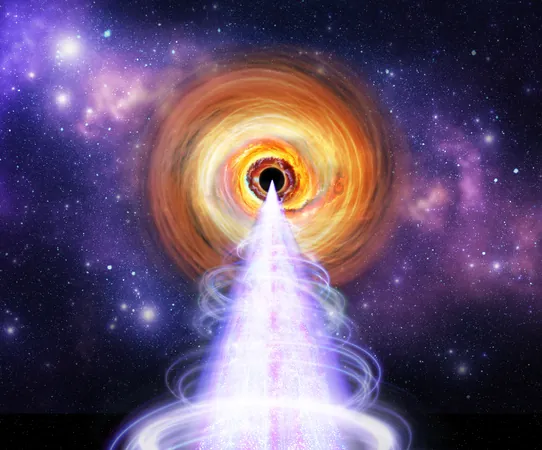
Revealing the Secrets of Black Hole Jets: How X-rays Shine in Extreme Environments
2025-05-06
Author: Sophie
A Breakthrough in Blazar Research
Astronomers have made a stunning discovery regarding BL Lacertae, a blazar that houses a supermassive black hole at its core, surrounded by dazzling jets aimed directly at Earth. This celestial body has provided scientists with vital insights into how X-rays are generated in some of the universe's most hostile environments.
The Role of IXPE in Unraveling Mysteries
The Imaging X-ray Polarimetry Explorer (IXPE), launched on December 9, 2021, teamed up with a host of radio and optical telescopes to investigate these enigmatic X-ray emissions. Their findings, soon to be published in the *Astrophysical Journal Letters*, reveal that fast-moving electrons engage in a dance with photons—essentially particles of light—to create X-rays.
The X-ray Dilemma: Electrons vs. Protons
Scientists had long debated two theories to explain the source of X-rays from black hole jets: one involving protons and another centered around electrons. The crucial factor was polarization—how light waves oscillate in space—which can distinguish between these potential origins. A high degree of polarization would indicate protons at play, while less polarization would signal that electrons are responsible.
Compton Scattering Reveals the Culprits
Through meticulous observation, the IXPE team concluded that electrons are indeed the main actors behind this X-ray production through a process known as Compton Scattering. Here, high-energy electrons collide with lower-energy photons, transferring energy and transforming them into higher-energy X-rays. IXPE’s capabilities allowed researchers to ascertain that electrons in the blazar’s jets are moving at nearly light speed, thus generating X-rays from infrared light.
Record-Setting Polarization Observations
Recent observations of BL Lacertae revealed something extraordinary. During a special observation period in late November 2023, IXPE recorded the highest optical polarization ever seen in any blazar at an astonishing 47.5%. This remarkable level of polarization, alongside the discovery that the X-rays received were only 7.6% polarized, further cemented the role of Compton scattering in this cosmic phenomenon.
The Journey Forward: Exploring More Blazars
With this breakthrough, researchers are eager to continue their exploration of blazars and their unpredictable nature. "These cosmic giants constantly surprise us," noted Steven Ehlert, project scientist for IXPE.
IXPE: A Joint Mission Making Stellar Discoveries
The IXPE mission, a collaboration between NASA and the Italian Space Agency, is setting new standards in astrophysics. With cutting-edge technology and international cooperation, IXPE is unraveling mysteries that have puzzled scientists for decades. Stay tuned as this mission continues to illuminate the darkest depths of the universe.









 Brasil (PT)
Brasil (PT)
 Canada (EN)
Canada (EN)
 Chile (ES)
Chile (ES)
 Česko (CS)
Česko (CS)
 대한민국 (KO)
대한민국 (KO)
 España (ES)
España (ES)
 France (FR)
France (FR)
 Hong Kong (EN)
Hong Kong (EN)
 Italia (IT)
Italia (IT)
 日本 (JA)
日本 (JA)
 Magyarország (HU)
Magyarország (HU)
 Norge (NO)
Norge (NO)
 Polska (PL)
Polska (PL)
 Schweiz (DE)
Schweiz (DE)
 Singapore (EN)
Singapore (EN)
 Sverige (SV)
Sverige (SV)
 Suomi (FI)
Suomi (FI)
 Türkiye (TR)
Türkiye (TR)
 الإمارات العربية المتحدة (AR)
الإمارات العربية المتحدة (AR)